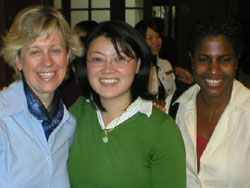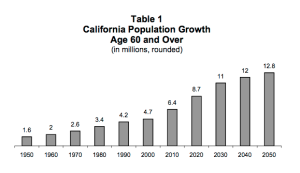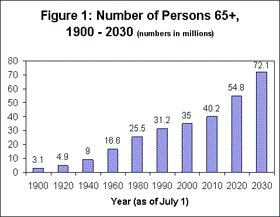Posts tagged ‘Bay Area’
The English Center: East Bay’s best kept secret?
I am mightily impressed by the English Center in Oakland. It’s a 30-year-old nonprofit preparing non-native speakers of English for full participation in American society. The center offers not only immersion in English language at seven different levels, but also computer training, job-specific test preparation, and employment services.
Lynne Wilkins, associate director for programs, gave me an extensive tour of classrooms and computer labs. The EC’s Jack London Square site is an open and spacious environment, with large common areas where students can gather. I sat in on three different language classes.
In the basic class students worked on verb conjugations: I like books. He likes television. We both like movies. The intermediate class listened for pronouns in the Beatles’ song “Something.” And the advanced class was working on articulation using tongue twisters: She sells sea shells by the seashore. Peter Piper picked a peck of pickled peppers. The rain in Spain stays mainly on the plain. “That one’s easy,” students said. Henry Higgins, take note.
 But what really moved me was the cultural, and cross-cultural, curriculum. It’s embodied in the diversity of students in every single classroom. Japanese businessman next to Russian healthcare worker next to preliterate Spanish speaker next to Eritrean refugee. Students must speak English to communicate with each other. Cultures bump up against each other, mix, collide. Language exercises are designed to bring these cultural issues to the fore.
But what really moved me was the cultural, and cross-cultural, curriculum. It’s embodied in the diversity of students in every single classroom. Japanese businessman next to Russian healthcare worker next to preliterate Spanish speaker next to Eritrean refugee. Students must speak English to communicate with each other. Cultures bump up against each other, mix, collide. Language exercises are designed to bring these cultural issues to the fore.
In the intermediate class, the students were grappling with social controversies and rehearsing polite phrases for agreement and disagreement. Should men fight alongside women in the military? Should parents stop supporting their children once the children are adults? Should women be married at 16? I feel the same way. / I see things differently. / I don’t agree. I sat with a group of three women (one East Asian, one Eastern European, one possibly Central American) who certainly had some opinions on what women could do! “You can agree, or disagree, as long as you’re respectful,” said the teacher. …I wish everyone were taking that lesson!
Over and over again I heard stories of the students’ lives which moved me. Immigrants who had made it to this country any way they could after a dozen years in refugee camps. Highly skilled professionals who are eager to work here, or to train here and take their skills back home. Students participating in mock elections at the center, engaging in political debates and casting their ballots, safely, for the first time in their lives.
Managing such diverse classrooms demands a lot pedagogically and emotionally from the English Center instructors, so the EC provides training and mentoring to prepare new teachers for this specific environment. And the English Center organization as a whole is also learning and growing rapidly – they’re expanding into providing training for entire companies and union groups. Student enrollment is up by 40% from two years ago.
The center’s programs are tuition based but most students receive financial aid. And, as is typical of many nonprofits, EC’s vision goes far beyond its funding. An interactive whiteboard, a digital camera, donations towards books: any of those would be a welcome fulfillment of the wish list. Volunteers are also needed. You may find me among them!
Tummeling? Yes: designing for conversation
Comedian, talk show host, and “UnPresenter” Heather Gold shows us all how to turn presentations into conversations. In comedy it’s called working the room, or tummeling.
Giving talks that “are more fun, require less preparation, and leave your audience feeling awesome”? Even in large groups?
Bay Area friends, you can see this in action. Heather’s got a free talk and two full-day workshops coming up. BayCHI members get a break on both the August 7 tutorial and the August 8 class.
And here’s a sample. In this Google talk Heather earns her pro status. They’ve only given her a podium mike, so she can’t move around to work the room. Watch her use friendly charm to draw in folks on the periphery.
You want to do everything you can to help people feel like they can be themselves. Because the best way to tummel is to be yourself, to be a really big version of yourself. Tummel means to make noise, to help people bring the noise.
Boom Towns
Worldchanging’s article on Boom Towns has me thinking about the effects of an aging population on the SF Bay Area.
In 2011, the first Boomer will turn 65, an occasion that will herald an epochal demographic shift. Just as babies boomed in the 1940s through 1960s, older adults will become North America’s – and much of the rest of the world’s – fastest-growing demographic. This imminent population shift is beginning to force a long-overdue conversation about the unique housing, environmental, and health care needs of an aging population.
Unfortunately, it’s a conversation that many of us are ill-prepared to undertake. A recent AARP study, for example, found a massive disconnect between perceptions of aging and its reality.
…These issues came to life for me several years ago, when my father, a California school teacher, started looking for his future retirement home in Oregon’s Willamette Valley. His criteria for the move, “I want to get away from the crowded [city] and find a place that is less hectic…somewhere I can grow things.”
…My father simply couldn’t fathom the changes that age would bring to his abilities or his faculties. Even though he has never wanted to burden anyone, it was tough for him to envision the kind of decline that would lead to needing help with driving, shopping—or growing things.
…Eventually we found a house across the street from a hospital, a half mile from a future light rail stop, with a ramp over the three stairs leading to the front door, and with plenty of room on the property to add additional square footage or an accessory dwelling unit if my sister, our family, or his friends wanted to join him in Portland.
California is a comparatively “young” state with a high birth rate, but it is not immune to the aging boom. The proportion of residents 60+ years of age is expected to increase by 59 percent between 2005 and 2020. By then, one in five Californians will be over 60.
And then there’s population growth and the sheer number of older people, continuing to grow sharply through 2030 at least.

The state’s report “Aging California” (pdf) notes that this growth will be unevenly distributed. Rural counties currently have lower populations, but a greater percentage of seniors. This is due to the flight of younger residents to urban areas to find work, plus the influx of retirees seeking new homes away from large cities.
Looking at local projections for the future, it’s harder to see a trend. For example, the Lassen-Shasta-Trinity area is expected to age slightly less than San Francisco (39% increase vs. 43%, if that’s significant). These are in turn surpassed by Riverside and San Diego (each near the average of 59%), Contra Costa (66%), and Sonoma (86%). It’s a complex mix of birth rates, employment patterns, migration, affordability, and retirement—and I’m sure none of these numbers reflect the recent financial meltdown.
Personally, I’m becoming increasingly mindful of transit patterns in my daily life. That last bus link from home to BART is weak—nonexistent at night—which means driving to the train station. Nor does the design of my home fit the Portland scenario above. More to think about. I’m determined to do better in my next move. And I won’t be tempted by anything like my in-laws’ Prescott Valley exurban retirement, no matter how inexpensive the real estate.
Carnival of Mobilists #190, plus events
![]() Caroline Lewko from WIPJAM hosts Carnival of Mobilists #190. This week’s collection includes A Mobile Learning Roundup of Sorts with news from the (Northern Hemisphere) summer season. We also get a snapshot of the fragmented world of developing for mobile – proliferation of platforms, barriers to app acceptance, and the rise of the netbook.
Caroline Lewko from WIPJAM hosts Carnival of Mobilists #190. This week’s collection includes A Mobile Learning Roundup of Sorts with news from the (Northern Hemisphere) summer season. We also get a snapshot of the fragmented world of developing for mobile – proliferation of platforms, barriers to app acceptance, and the rise of the netbook.
And a WIPJam itself may be coming to your town.
WIP (Wireless Industry Partnership) is about connecting developers to the information, resources and people important for innovation, growing your business and getting to market faster. …
Jam Sessions are interactive and definitely not boring. We mean it when we say No PPT, No Panels and No Ties! WIP Jam sessions are a unique format for mobile and wireless developers, where we blend ‘unpanels’, with intimate discussion groups led by industry leaders and developers alike. And it’s really very interactive – we make sure everyone gets a chance to be heard.
There’s a WIPJAM @ OSIM (Open Source in Mobile World) in Amsterdam next week, September 16, and also WIPJAM @ CTIA in San Diego, CA on October 8.
I’ll be at an event closer to home next month: Mobile 2.0. It’s really two conferences in two locations: a business day in San Francisco October 15, and a developer day in Mountain View October 16. I’m registered for the latter… but if a free pass turned up for the biz day I’d take it in a shot.
News In Brief, Aug. 13, 2009
This week’s research focuses on technology infrastructure for emerging markets. As usual I pick up other things along the way.
- Vital Wave Consulting’s Brooke Partridge addressed the PARC Forum on Expecting the unexpected: Technology in emerging markets (précis and video). She gave a useful overview of demographic and technological trends, then focused on mobile applications and challenges to large-scale adoption beyond pilot programs.
- M-PESA in Kenya actually is an early success story in mobile banking. But how are people using the service? What are the social impacts on households who have members in both urban and rural settings? CGAP’s notable ethnographic brief shares 10 findings: Poor People Using Mobile Financial Services: Observations on Customer Usage and Impact from M-PESA (pdf).
- M-PESA meets microfinance as payments are made via mobile phone, in this brief case study from Triple Jump (thanks, @jehahn).
- CGAP also hosted a recent webinar on “banking where electrons have never been before.” Panelists from FINCA, Opportunity International, and the Grameen Technology Center discussed the particular challenges of MIS systems for rural microfinance. CGAP’s survey of 152 microfinance institutions worldwide is a good snapshot of the computing challenges.
- Next Wednesday 8/19 I’ll be at the Silicon Valley Microfinance Network meeting in San Francisco. Stephen Goodman of Sun will be speaking on Emerging Engagement Models: Lessons from the intersection of emerging technologies and emerging economies. Looking forward to it!
I’m keeping tabs on banking trends that go beyond microcredit to other financial services.
- The topic got my attention at Microfinance California 2009. Slides from the panel on “Beyond Microfinance Lending: New Consumer Products” are available. Sarah Gordon of CSFI reminded us that 40 million people in the US are un- or under-banked, and that underbanked isn’t subprime (pdf). The panelists (Prosper Marketplace, Progreso Financial, Community Financial Resources, and Pacific Community Ventures) touched on debit cards, bill paying, health care reimbursement, savings, and investment services.
- This week, the Gates Foundation announced $350M in grants for international projects to help the poor build savings. Poor rural people incur large expenses to put their money in distant banks. Or, they attempt to stockpile cash, jewelry, extra building materials and spare animals – but “stuff gets stolen, animals die,” and informal savings lose a fifth of their value. Instead, these projects will let people store and access cash deposits via their local post office, lottery outpost, or cellphone account.
And this afternoon, Thursday 8/13, I’ll be at PARC to hear Marissa Mayer speak on “Innovation at Google: The Physics of Data.”
Technologies for sensing, storing, and sharing information are driving innovation in the tools available to help us understand our world in greater detail and accuracy than ever before. The implications of analyzing data on a massive scale transcend the tech industry, impacting the environmental sector, social justice issues, health and science research, and more. When coupled with astute technical insight, data is dynamic, accessible, and ultimately, creative.
August 19 microfinance events, SF
Two microfinance events in San Francisco on Wednesday evening, 8/19. Almost close enough that you could think about going to both. But I expect discussion to be lively at each one, so how could you pry yourself free?
Girls in Tech presents How Microfinance is Changing the Way We Live. The panel discussion features prominent women from Kiva, Wokai, Microplace, PayPal, and TMC Working Solutions. Admission is $10.
The Silicon Valley Microfinance Network hosts Sun’s Stephen Goodman on
Emerging Engagement Models: Lessons from the intersection of emerging technologies and emerging economies. Admission, which includes dinner, is $20 in advance or $30 at the door.
